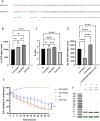The pseudoknot region and poly-(C) tract comprise an essential RNA packaging signal for assembly of foot-and-mouth disease virus
- PMID: 39715215
- PMCID: PMC11734982
- DOI: 10.1371/journal.ppat.1012283
The pseudoknot region and poly-(C) tract comprise an essential RNA packaging signal for assembly of foot-and-mouth disease virus
Abstract
Virus assembly is a crucial step for the completion of the viral replication cycle. In addition to ensuring efficient incorporation of viral genomes into nascent virions, high specificity is required to prevent incorporation of host nucleic acids. For picornaviruses, including FMDV, the mechanisms required to fulfil these requirements are not well understood. However, recent evidence has suggested that specific RNA sequences dispersed throughout picornavirus genomes are involved in packaging. Here, we have shown that such sequences are essential for FMDV RNA packaging and have demonstrated roles for both the pseudoknot (PK) region and the poly-(C) tract in this process, where the length of the poly-(C) tract was found to influence the efficiency of RNA encapsidation. Sub-genomic replicons containing longer poly-(C) tracts were packaged with greater efficiency in trans, and viruses recovered from transcripts containing short poly-(C) tracts were found to have greatly extended poly-(C) tracts after only a single passage in cells, suggesting that maintaining a long poly-(C) tract provides a selective advantage. We also demonstrated a critical role for a packaging signal (PS) located in the pseudoknot (PK) region, adjacent to the poly-(C) tract, as well as several other non-essential but beneficial PSs elsewhere in the genome. Collectively, these PSs greatly enhanced encapsidation efficiency, with the poly-(C) tract possibly facilitating nearby PSs to adopt the correct conformation. Using these data, we have proposed a model where interactions with capsid precursors control a transition between two RNA conformations, directing the fate of nascent genomes to either be packaged or alternatively to act as templates for replication and/or for protein translation.
Copyright: © 2024 Neil et al. This is an open access article distributed under the terms of the Creative Commons Attribution License, which permits unrestricted use, distribution, and reproduction in any medium, provided the original author and source are credited.
Conflict of interest statement
The authors have declared that no competing interests exist.
Figures









Similar articles
-
Deep Sequencing of Foot-and-Mouth Disease Virus Reveals RNA Sequences Involved in Genome Packaging.J Virol. 2017 Dec 14;92(1):e01159-17. doi: 10.1128/JVI.01159-17. Print 2018 Jan 1. J Virol. 2017. PMID: 29046452 Free PMC article.
-
The RNA pseudoknots in foot-and-mouth disease virus are dispensable for genome replication, but essential for the production of infectious virus.PLoS Pathog. 2022 Jun 6;18(6):e1010589. doi: 10.1371/journal.ppat.1010589. eCollection 2022 Jun. PLoS Pathog. 2022. PMID: 35666744 Free PMC article.
-
Packaging signals in two single-stranded RNA viruses imply a conserved assembly mechanism and geometry of the packaged genome.J Mol Biol. 2013 Sep 9;425(17):3235-49. doi: 10.1016/j.jmb.2013.06.005. Epub 2013 Jun 11. J Mol Biol. 2013. PMID: 23763992
-
RNA Structures and Their Role in Selective Genome Packaging.Viruses. 2021 Sep 8;13(9):1788. doi: 10.3390/v13091788. Viruses. 2021. PMID: 34578369 Free PMC article. Review.
-
Foot-and-mouth disease virus.Comp Immunol Microbiol Infect Dis. 2002 Oct;25(5-6):297-308. doi: 10.1016/s0147-9571(02)00027-9. Comp Immunol Microbiol Infect Dis. 2002. PMID: 12365806 Review.
Cited by
-
A veterinary virapalooza: a summary of the 2024 American Society for Virology (ASV) Veterinary/Zoonotic Virology Satellite Symposium and online H5N1 panel discussion.J Virol. 2025 Jun 17;99(6):e0049925. doi: 10.1128/jvi.00499-25. Epub 2025 May 13. J Virol. 2025. PMID: 40358208 Free PMC article. Review.
References
MeSH terms
Substances
LinkOut - more resources
Full Text Sources

